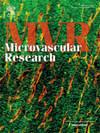新型自适应光学激光多普勒测速仪在原发性开角型青光眼视网膜血流中的应用。
IF 2.7
4区 医学
Q2 PERIPHERAL VASCULAR DISEASE
引用次数: 0
摘要
目的:测定原发性开角型青光眼(POAG)患者视网膜静脉血流(RBF),并与健康对照进行比较。次要目的是确定RBF与视野(VF)损失或视网膜神经纤维层(RNFL)厚度之间的相关性。方法:采用前瞻性单中心研究,选取12例POAG患者和11例健康对照。我们的原型自适应光学激光多普勒测速仪(AO-LDV)由激光多普勒测速仪和自适应光学眼底相机(rtx1, Imagine Eyes®)组成,可以测量血管直径,从而计算血管内的血流。比较颞上静脉(STV)与颞下静脉(ITV)的血流情况。所有受试者均接受眼部检查,包括视野(Humphrey 24-2 sita标准策略)和使用Cirrus HD-OCT(视盘200 × 200立方)测量视网膜神经纤维层(RNFL)厚度。青光眼组研究部门结构-功能关系。结果:青光眼组STV速度(6.30 ± 1.6 mm/s)低于对照组(8.6 ± 2.8 mm/s, p = 0.07),ITV无显著性差异。两组间STV或ITV直径无显著差异。我们发现STV或ITV视网膜血流与视野或RNFL厚度没有关系。结论:我们的原型AO-LDV可以准确测量青光眼患者的RBF,并显示在青光眼的早期或中度阶段RBF不会降低。这些数据表明,在青光眼的早期阶段,视网膜血流量并没有明显减少。这些初步结果应在更大的研究中得到证实,特别是在晚期青光眼中。本文章由计算机程序翻译,如有差异,请以英文原文为准。
Retinal blood flow in eyes with primary open-angle glaucoma using a new Adaptive Optics Laser Doppler Velocimeter device
Purpose
To measure retinal blood flow (RBF) in the retinal veins of patients with primary open-angle glaucoma (POAG) and to compare it with healthy controls. A secondary objective was to determine any correlation between RBF and visual field (VF) loss or retinal nerve-fiber layer (RNFL) thickness.
Method
Twelve patients with POAG and 11 healthy controls were included in a prospective single-center study. Our prototype Adaptive Optics Laser Doppler Velocimeter (AO-LDV) consisted of a laser Doppler velocimeter combined with an adaptive optic fundus camera (rtx1, Imagine Eyes®) allowing measurement of blood vessel diameter and therefore, calculation of blood flow within the vessel. Blood flow in the superior temporal vein (STV) was compared with that in the inferior temporal vein (ITV). All subjects underwent eye examinations including visual field (Humphrey 24-2 SITA-standard strategy) and measurement of retinal nerve-fiber layer (RNFL) thickness using a Cirrus HD-OCT (optic disc 200 × 200 cube) protocol. Sectoral structure-function relationships were studied in the glaucoma group.
Results
The velocity in the STV was lower in the glaucoma group (6.30 ± 1.6 mm/s) compared to the control group (8.6 ± 2.8 mm/s, p = 0.07), with no significant differences in the ITV. There were no significant differences in STV or ITV diameters between the groups. We found no relationship between either STV or ITV retinal blood flow and visual field or RNFL thickness.
Conclusion
Our prototype AO-LDV allowed accurate measurement of RBF in patients with glaucoma and showed that RBF was not reduced in the early or moderate stages of glaucoma. These preliminary results should be confirmed in a larger study, especially in late-stage glaucoma.
求助全文
通过发布文献求助,成功后即可免费获取论文全文。
去求助
来源期刊

Microvascular research
医学-外周血管病
CiteScore
6.00
自引率
3.20%
发文量
158
审稿时长
43 days
期刊介绍:
Microvascular Research is dedicated to the dissemination of fundamental information related to the microvascular field. Full-length articles presenting the results of original research and brief communications are featured.
Research Areas include:
• Angiogenesis
• Biochemistry
• Bioengineering
• Biomathematics
• Biophysics
• Cancer
• Circulatory homeostasis
• Comparative physiology
• Drug delivery
• Neuropharmacology
• Microvascular pathology
• Rheology
• Tissue Engineering.
 求助内容:
求助内容: 应助结果提醒方式:
应助结果提醒方式:


